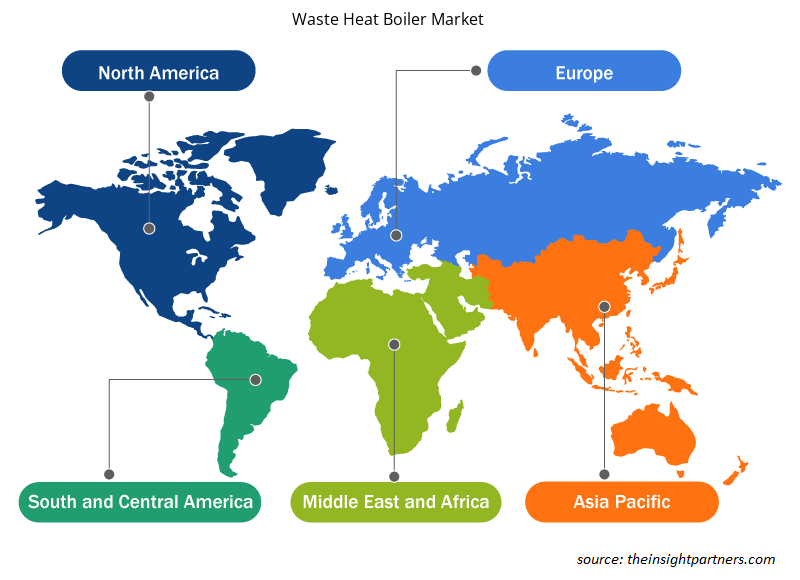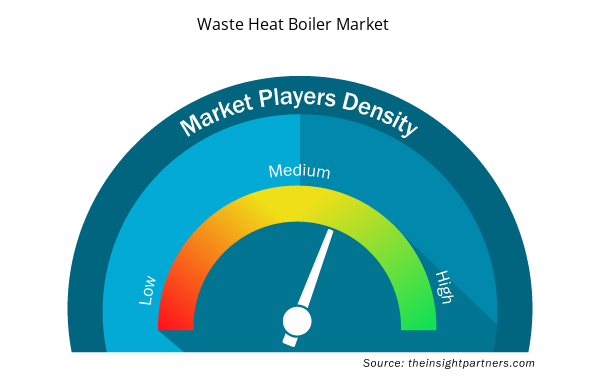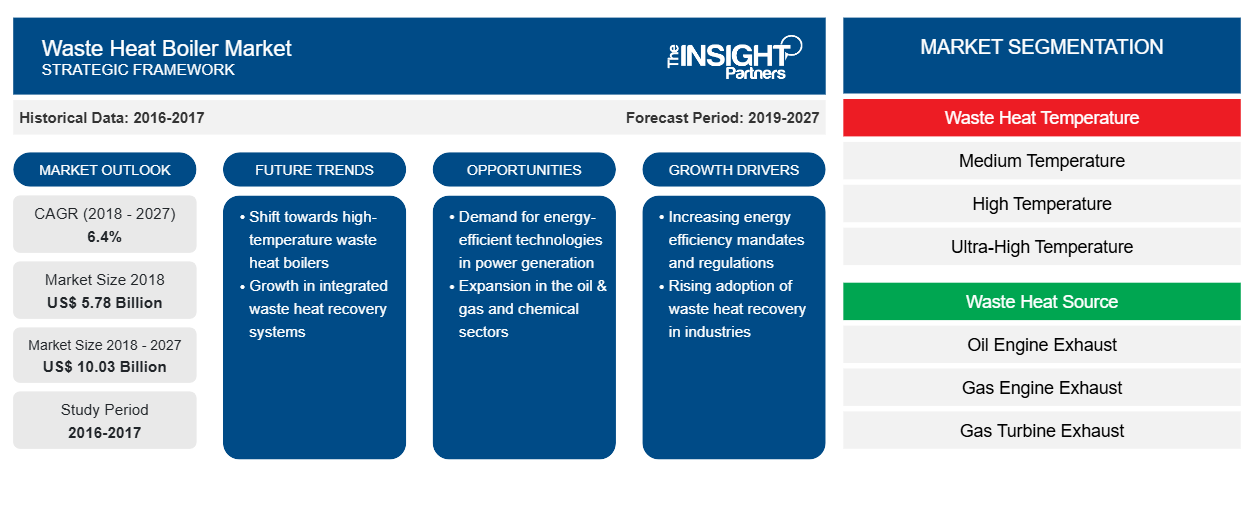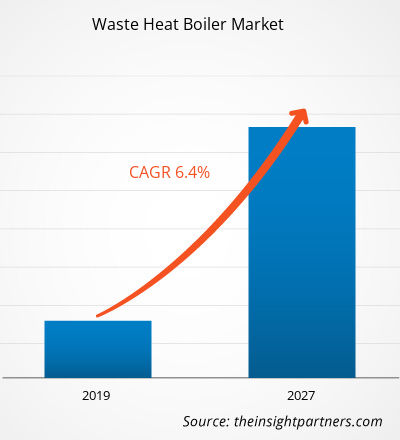[研究报告] 2018 年全球余热锅炉市场规模估计为 57.8 亿美元,预计在 2019 年至 2027 年的预测期内复合年增长率为 6.4%,到 2027 年将达到 100.3 亿美元。
政府越来越重视开发高效的能源解决方案,以及各种实施废热锅炉的政府计划,这推动了废热锅炉市场的发展。随着能源价格的上涨,各行业高度关注实施废热回收系统。这是减少燃料消耗、提高生产效率和降低有害排放的关键研究领域之一。工业废热是由没有任何实际用途并被排放到环境中的工业过程产生的。预计中东和非洲废热锅炉市场在 2019 年至 2027 年期间的复合年增长率将达到 6.7%。
余热锅炉市场洞察
有吸引力的政府举措
工业废热是发电、石油和天然气、化学品、原生金属、非金属矿物等行业的核心工业过程中产生的能量,这些废热通过各种废热回收技术进行处理,以提供有价值的能源并降低总体能源消耗。根据美国能源部的数据,大约 20% 到 50% 的工业能源以废气形式的废热形式减少。随着工业部门继续努力提高能源效率,它将回收废热损失,减少对环境的影响,并提高工作流程和生产力。各种政府举措是废热锅炉市场增长的主要驱动力之一。各国政府的举措在成功实施废热锅炉方面发挥着重要作用,这将进一步增加对废热锅炉市场的需求。从而推动未来几年废热锅炉市场的增长。
定制此报告以满足您的需求
您可以免费定制任何报告,包括本报告的部分内容、国家级分析、Excel 数据包,以及为初创企业和大学提供优惠和折扣
- 获取此报告的关键市场趋势。这个免费样品将包括数据分析,从市场趋势到估计和预测。
采用节能解决方案的人数激增
未来,节能解决方案很可能会迎来大量需求。废热锅炉是一种节能设备,用于回收废热能源,可以降低未来的运营成本、资本投资和公用设施系统成本。废热锅炉的性能是商业设施降低公用设施成本的关键因素。对于各行各业的维护和工程程序,企业试图提供高效的锅炉性能,锅炉的效率取决于热量输出与燃料使用量的比例。根据美国能源部的数据,传统供暖系统的运行效率通常在 56% 到 70% 之间,这在节能方面是一个巨大的损失。然而,现代锅炉和热水器的运行效率在 80% 左右,在许多行业中使用时可以显著节省能源。因此,开发技术有望比传统技术更有效地回收废热。
余热锅炉市场 – 余热温度细分洞察
根据工艺类型,工业炉或窑炉几乎可以在任何温度下释放废热。通常,高温产生的废热大部分来自直接燃烧过程;中温产生的热量来自燃烧装置的排气;低温产生的热量来自产品、零件和工艺装置设备。废热回收发电效率在很大程度上取决于废热源温度。一般而言,经济可行的废热发电主要限于中高温或超高温废热源。
余热锅炉市场 – 余热源细分洞察
工业中的能源密集型过程,包括钢厂、炼油厂、玻璃熔炉和水泥窑中的过程,都会释放出热废气和废物流,这些废物流可以通过废热锅炉等热回收技术来利用,以发电。从熔炉中释放出来的废气含有大量的热能。在多种燃料加热系统中,废热是过程中热量损失的最终来源,通常超过所有其他损失的总和。根据工艺和设备的类型,废热源分为燃油发动机废气、燃气发动机废气、燃气轮机废气、焚化炉排气、窑炉和熔炉气体等。
余热锅炉市场 – 细分市场洞察
废热锅炉市场按方向可分为卧式锅炉和立式锅炉。每种锅炉的废热回收能力取决于锅炉效率。此外,方向的选择主要取决于安装地点。立式锅炉通常适用于小型和狭窄的应用,而卧式锅炉则大多部署在宽敞的场地。这两种锅炉的应用领域不同,因此选择完全取决于客户的要求。
余热锅炉市场 – 终端用户细分洞察
不同行业使用的大量能源被浪费为离开工业设施的热量。这些包括气流、废气和液体。虽然从经济和技术角度来看,回收所有废热都是不可行的,但一定量的热量可以通过各种热回收程序回收。一项研究表明,废热回收可以替代美国工业使用的总能源的约 9%,这最终将有助于提高美国的全球竞争力。这将有助于进一步减少温室气体的排放。废热回收机会的潜力因行业而异。预计原金属将成为废热锅炉市场终端用户的主要市场驱动力。
一些市场举措被观察到是全球余热锅炉市场最常采用的策略。以下列出了余热回收锅炉市场参与者最近采用的一些市场举措:
2019 年:蒂森克虏伯工业印度公司宣布与 Gainwell 达成协议,Gainwell 是采矿、建筑和电力解决方案的领先分销商。该协议将有助于该公司巩固其在印度市场的地位。2018
年:罗伯特博世宣布在中国苏州成立新的研发中心。这个新的研发中心拥有约 1,500 名员工,主要专注于移动和互联解决方案的制造。2018
年:Thermax 赢得了印度一家钢铁巨头 34 亿卢比的订单。该订单包括专门设计的锅炉、电动涡轮发电机和生产设施的辅助设备。蒸汽锅炉将利用钢铁制造产生的废气产生高压蒸汽来发电。
废热锅炉市场区域洞察
Insight Partners 的分析师已详细解释了预测期内影响废热锅炉市场的区域趋势和因素。本节还讨论了北美、欧洲、亚太地区、中东和非洲以及南美和中美洲的废热锅炉市场细分和地理位置。

- 获取余热锅炉市场的区域特定数据
余热锅炉市场报告范围
| 报告属性 | 细节 |
|---|---|
| 2018 年市场规模 | 57.8亿美元 |
| 2027 年市场规模 | 100.3亿美元 |
| 全球复合年增长率(2018 - 2027) | 6.4% |
| 史料 | 2016-2017 |
| 预测期 | 2019-2027 |
| 涵盖的领域 | 按废热温度
|
| 覆盖地区和国家 | 北美
|
| 市场领导者和主要公司简介 |
|
余热锅炉市场参与者密度:了解其对业务动态的影响
废热锅炉市场正在快速增长,这得益于终端用户需求的不断增长,而这些需求又源于消费者偏好的不断变化、技术进步以及对产品优势的认识不断提高等因素。随着需求的增加,企业正在扩大其产品范围,进行创新以满足消费者的需求,并利用新兴趋势,从而进一步推动市场增长。
市场参与者密度是指在特定市场或行业内运营的企业或公司的分布情况。它表明在给定市场空间中,相对于其规模或总市场价值,有多少竞争对手(市场参与者)存在。
在余热锅炉市场运营的主要公司有:
- 通用电气
- 诺特/埃里克森
- 罗伯特·博世有限公司
- 瑟玛克斯
- 蒂森克虏伯
免责声明:上面列出的公司没有按照任何特定顺序排列。

- 了解废热锅炉市场顶级关键参与者概况
全球余热锅炉市场细分
全球余热锅炉市场 – 按余热温度
- 中温
- 高温
- 超高溫
全球余热锅炉市场 – 按余热源分类
- 机油发动机排气
- 燃气发动机排气
- 燃气轮机排气
- 焚烧炉排放气体
- 窑炉气体
- 其他的
全球余热锅炉市场 – 按方向划分
- 水平的
- 垂直的
全球余热锅炉市场 – 按最终用户划分
- 发电设施
- 石油和天然气
- 化学
- 初级金属
- 非金属矿产
- 其他的
全球余热锅炉市场 – 按地区划分
北美
- 我们
- 加拿大
- 墨西哥
欧洲
- 法国
- 德国
- 意大利
- 英国
- 欧洲其他地区
亚太地区 (APAC)
- 中国
- 印度
- 日本
- 澳大利亚
- 韩国
- 亚太地区其他地区
中东和非洲 (MEA)
- 沙特阿拉伯
- 阿联酋
- 南非
- 中东和非洲其他地区
南美洲
- 巴西
- 南美洲其他地区
全球余热锅炉市场 - 公司简介
- 阿法拉伐
- CiTECH 能源回收解决方案(英国)有限公司
- 通用电气
- 川崎重工业株式会社
- 诺特/埃里克森
- 博世集团
- 特玛克斯有限公司
- 蒂森克虏伯股份公司
- 菲斯曼集团
- 郑州锅炉股份有限公司
- 历史分析(2 年)、基准年、预测(7 年)及复合年增长率
- PEST 和 SWOT 分析
- 市场规模价值/数量 - 全球、区域、国家
- 行业和竞争格局
- Excel 数据集



Report Coverage
Revenue forecast, Company Analysis, Industry landscape, Growth factors, and Trends

Segment Covered
This text is related
to segments covered.

Regional Scope
North America, Europe, Asia Pacific, Middle East & Africa, South & Central America

Country Scope
This text is related
to country scope.
Trends and growth analysis reports related to Manufacturing and Construction : READ MORE..
The List of Companies
- General electric
- Nooter/eriksen
- Robert Bosch GMBH
- Thermax
- Thyssenkrupp
- Viessmann Group
- Zhengzhou Boiler Co. Ltd.
- Kawasaki Heavy Industries, Ltd.
- CiTECH Energy Recovery Solutions (UK) LTD
- Alfa Laval
The Insight Partners performs research in 4 major stages: Data Collection & Secondary Research, Primary Research, Data Analysis and Data Triangulation & Final Review.
- Data Collection and Secondary Research:
As a market research and consulting firm operating from a decade, we have published and advised several client across the globe. First step for any study will start with an assessment of currently available data and insights from existing reports. Further, historical and current market information is collected from Investor Presentations, Annual Reports, SEC Filings, etc., and other information related to company’s performance and market positioning are gathered from Paid Databases (Factiva, Hoovers, and Reuters) and various other publications available in public domain.
Several associations trade associates, technical forums, institutes, societies and organization are accessed to gain technical as well as market related insights through their publications such as research papers, blogs and press releases related to the studies are referred to get cues about the market. Further, white papers, journals, magazines, and other news articles published in last 3 years are scrutinized and analyzed to understand the current market trends.
- Primary Research:
The primarily interview analysis comprise of data obtained from industry participants interview and answers to survey questions gathered by in-house primary team.
For primary research, interviews are conducted with industry experts/CEOs/Marketing Managers/VPs/Subject Matter Experts from both demand and supply side to get a 360-degree view of the market. The primary team conducts several interviews based on the complexity of the markets to understand the various market trends and dynamics which makes research more credible and precise.
A typical research interview fulfils the following functions:
- Provides first-hand information on the market size, market trends, growth trends, competitive landscape, and outlook
- Validates and strengthens in-house secondary research findings
- Develops the analysis team’s expertise and market understanding
Primary research involves email interactions and telephone interviews for each market, category, segment, and sub-segment across geographies. The participants who typically take part in such a process include, but are not limited to:
- Industry participants: VPs, business development managers, market intelligence managers and national sales managers
- Outside experts: Valuation experts, research analysts and key opinion leaders specializing in the electronics and semiconductor industry.
Below is the breakup of our primary respondents by company, designation, and region:

Once we receive the confirmation from primary research sources or primary respondents, we finalize the base year market estimation and forecast the data as per the macroeconomic and microeconomic factors assessed during data collection.
- Data Analysis:
Once data is validated through both secondary as well as primary respondents, we finalize the market estimations by hypothesis formulation and factor analysis at regional and country level.
- Macro-Economic Factor Analysis:
We analyse macroeconomic indicators such the gross domestic product (GDP), increase in the demand for goods and services across industries, technological advancement, regional economic growth, governmental policies, the influence of COVID-19, PEST analysis, and other aspects. This analysis aids in setting benchmarks for various nations/regions and approximating market splits. Additionally, the general trend of the aforementioned components aid in determining the market's development possibilities.
- Country Level Data:
Various factors that are especially aligned to the country are taken into account to determine the market size for a certain area and country, including the presence of vendors, such as headquarters and offices, the country's GDP, demand patterns, and industry growth. To comprehend the market dynamics for the nation, a number of growth variables, inhibitors, application areas, and current market trends are researched. The aforementioned elements aid in determining the country's overall market's growth potential.
- Company Profile:
The “Table of Contents” is formulated by listing and analyzing more than 25 - 30 companies operating in the market ecosystem across geographies. However, we profile only 10 companies as a standard practice in our syndicate reports. These 10 companies comprise leading, emerging, and regional players. Nonetheless, our analysis is not restricted to the 10 listed companies, we also analyze other companies present in the market to develop a holistic view and understand the prevailing trends. The “Company Profiles” section in the report covers key facts, business description, products & services, financial information, SWOT analysis, and key developments. The financial information presented is extracted from the annual reports and official documents of the publicly listed companies. Upon collecting the information for the sections of respective companies, we verify them via various primary sources and then compile the data in respective company profiles. The company level information helps us in deriving the base number as well as in forecasting the market size.
- Developing Base Number:
Aggregation of sales statistics (2020-2022) and macro-economic factor, and other secondary and primary research insights are utilized to arrive at base number and related market shares for 2022. The data gaps are identified in this step and relevant market data is analyzed, collected from paid primary interviews or databases. On finalizing the base year market size, forecasts are developed on the basis of macro-economic, industry and market growth factors and company level analysis.
- Data Triangulation and Final Review:
The market findings and base year market size calculations are validated from supply as well as demand side. Demand side validations are based on macro-economic factor analysis and benchmarks for respective regions and countries. In case of supply side validations, revenues of major companies are estimated (in case not available) based on industry benchmark, approximate number of employees, product portfolio, and primary interviews revenues are gathered. Further revenue from target product/service segment is assessed to avoid overshooting of market statistics. In case of heavy deviations between supply and demand side values, all thes steps are repeated to achieve synchronization.
We follow an iterative model, wherein we share our research findings with Subject Matter Experts (SME’s) and Key Opinion Leaders (KOLs) until consensus view of the market is not formulated – this model negates any drastic deviation in the opinions of experts. Only validated and universally acceptable research findings are quoted in our reports.
We have important check points that we use to validate our research findings – which we call – data triangulation, where we validate the information, we generate from secondary sources with primary interviews and then we re-validate with our internal data bases and Subject matter experts. This comprehensive model enables us to deliver high quality, reliable data in shortest possible time.


 获取此报告的免费样本
获取此报告的免费样本